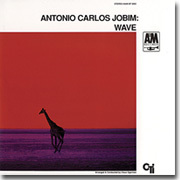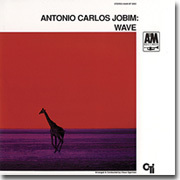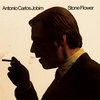SORRY - SOLD OUT
AAA 100% Analogue This LP was Remastered using Pure Analogue Components Only from the Master Tapes through to the Cutting Head
Speakers Corner / A&M CTI - SP-3002 - 180 Gram Virgin Vinyl -
AAA 100% Analogue - Limited Edition - Audiophile Mastering - Pressed at Pallas Germany
When CREED TAYLOR left Verve/MGM for his own label under the auspices of A&M, he quickly signed Antonio Carlos Jobim and they picked up right where they left off with this stunningly seductive record, possibly JOBIM's best.
JOBIM contributes his sparely rhythmic acoustic guitar, simple melodic piano style, a guest turn at the harpsichord, and even a vocal on "Lamento," lends a romantically brooding hand with the charts. A pair of instant standards are introduced ("Wave," "Triste"), but this album is to be cherished for its absolutely first-rate tunes
-- actually miniature tone poems -- that escaped overexposure and thus sound fresh today. The most beautiful sleeper is "Batidinha," where the intuitive JOBIM.OGERMAN collaboration reaches its peak.
One only wishes that this album were longer; 31:45 is not enough.
By the time this album was released, Antonio Carlos Jobim was already an international superstar. Having recently won a Grammy (1965) for “The Girl From Ipanema”, by 1967 all the big name stars from up north were breaking down his door to work with the new “Gershwin of Brazil.” In fact, Jobim had just finished working on an album with Frank Sinatra when he went into the studio to record this album.
Recorded in 1967, Wave is actually one of the lesser known masterpieces of Brazilian music, and undoubtedly one of Jobim’s greatest. Here Jobim and the great Claus Ogerman lead a top-flight cast on hidden classics like Batidinha, Triste and Wave.
Expectations run high when a successful producer resigns his post to join a rival company. Things were no different in the case of Creed Taylor who left Verve for A&M, taking along the bossa guru Jobim. This liaison resulted in the album Wave, which Latin specialists regard as one of the most artistic ever, perhaps because Jobim rides the gentlest of waves in this particular recording. While the large instrumental ensemble might lead one to suspect that sensationalism was the aim here, listening to the music proves that Jobim has remained true to his clear melodies and his simple, sensitive style. A relaxed carpet of sound is rolled out which enhances and refines the essence of Jobim’s musical roots, turning them into miniature tone poems.
Selections:
1. Wave
2. The Red Blouse
3. Look to the Sky
4. Batidinha
5. Triste
6. Mojave
7. Dialogo
8. Lamento
9. Antigua
10. Captain Bacardi
Englewood Cliffs, New Jersey: May 22, 23, 24 and June 15, 1967
Urbie Green, Jimmy Cleveland (tb); Joseph Singer (fhr); Ray Beckenstein, Romeo Penque, Jerome Richardson (f, pic); Antonio Carlos Jobim (p,g,harpsichord,vcl on h); Ron Carter (b); Claudio Slon (d); Dom Um Romao, Bobby Rosengarden (perc), Bernard Eichen, Lewis Eley, Paul Gershman, Emanuel Green, Louis Haber, Julius Held, Leo Kruczek, Harry Lookofsky, Joseph Malignaggi, Gene Orloff, Raoul Poliakin, Irving Spice, Louis Stone (vln); Abe Kessler, Charles McCracken, George Ricci, Harvey Shapiro (cello); Claus Ogerman (arr, cond).

20 Years pure Analogue
Are your records completely analogue?
Yes! This we guarantee!
As a matter of principle, only analogue masters are used, and the necessary cutting delay is also analogue. All our cutting engineers use only Neumann cutting consoles, and these too are analogue. The only exception is where a recording has been made – either partly or entirely – using digital technology, but we do not have such items in our catalogue at the present time
Are your records cut from the original masters?
In our re-releases it is our aim to faithfully reproduce the original intentions of the musicians and recording engineers which, however, could not be realised at the time due to technical limitations. Faithfulness to the original is our top priority, not the interpretation of the original: there is no such thing as a “Speakers Corner Sound”. Naturally, the best results are obtained when the original master is used. Therefore we always try to locate these and use them for cutting. Should this not be possible, – because the original tape is defective or has disappeared, for example – we do accept a first-generation copy. But this remains an absolute exception for us.
Who cuts the records?
In order to obtain the most faithful reproduction of the original, we have the lacquers cut on the spot, by engineers who, on the whole, have been dealing with such tapes for many years. Some are even cut by the very same engineer who cut the original lacquers of the first release. Over the years the following engineers have been and still are working for us: Tony Hawkins, Willem Makkee, Kevin Gray, Maarten de Boer, Scott Hull, and Ray Staff, to name but a few.
At the beginning of the ‘90s, in the early days of audiophile vinyl re-releases, the reissue policy was fairly straightforward. Companies such as DCC Compact Classics, Mobile Fidelity, Classic Records and others, including of course Speakers Corner, all maintained a mutual, unwritten code of ethics: we would manufacture records sourced only from analogue tapes.
Vinyl’s newfound popularity has led many other companies to jump on the bandwagon in the hope of securing a corner of the market. Very often they are not so ethical and use every imaginable source from which to master: CDs, LPs, digital files and even MP3s.
Even some who do use an analogue tape source employ a digital delay line, a misguided ’80s and ‘90s digital technology that replaces the analogue preview head originally used to “tell” the cutter head in advance what was about to happen musically, so it could adjust the groove “pitch” (the distance between the grooves) to make room for wide dynamic swings and large low frequency excursions. Over time analogue preview heads became more rare and thus expensive.
So while the low bit rate (less resolution than a 16 bit CD) digital delay line is less expensive and easier to use than an analogue “preview head”, its use, ironically, results in lacquers cut from the low bit rate digital signal instead of from the analogue source!
Speakers Corner wishes to make clear that it produces lacquers using only original master tapes and an entirely analogue cutting system. New metal stampers used to press records are produced from that lacquer. The only exceptions are when existing metal parts are superior to new ones that might be cut, which includes our release of “Elvis is Back”, which was cut by Stan Ricker or several titles from our Philips Classics series, where were cut in the 1990s using original master tapes by Willem Makkee at the Emil Berliner Studios. In those cases we used only the original “mother” to produce new stampers.
In addition, we admit to having one digital recording in our catalogue: Alan Parsons’ “Eye in the Sky”, which was recorded digitally but mixed to analogue tape that we used to cut lacquers.
In closing, we want to insure our loyal customers that, with but a few exceptions as noted, our releases are “AAA”— analogue tape, an all analogue cutting system, and newly cut lacquers.











